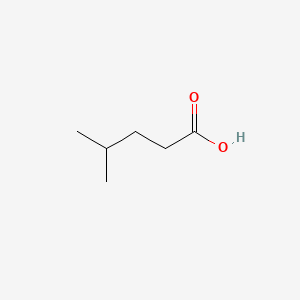| MeSH term | MeSH ID | Detail |
|---|---|---|
| Diarrhea | D003967 | 32 associated lipids |
| Diabetes Mellitus, Type 1 | D003922 | 56 associated lipids |
| Diabetes Mellitus, Type 2 | D003924 | 87 associated lipids |
| Edema | D004487 | 152 associated lipids |
| Occupational Diseases | D009784 | 42 associated lipids |
| Anemia, Sickle Cell | D000755 | 34 associated lipids |
| Clostridium Infections | D003015 | 5 associated lipids |
4-METHYLPENTANOIC ACID
4-METHYLPENTANOIC ACID is a lipid of Fatty Acyls (FA) class. The involved functions are known as CoA-transferase activity. 4-methylpentanoic acid often locates in Cytosol. The related lipids are Fatty Acids and alpha-ketocaproic acid.
Cross Reference
Introduction
To understand associated biological information of 4-METHYLPENTANOIC ACID, we collected biological information of abnormalities, associated pathways, cellular/molecular locations, biological functions, related genes/proteins, lipids and common seen animal/experimental models with organized paragraphs from literatures.
What diseases are associated with 4-METHYLPENTANOIC ACID?
There are no associated biomedical information in the current reference collection.
Possible diseases from mapped MeSH terms on references
We collected disease MeSH terms mapped to the references associated with 4-METHYLPENTANOIC ACID
PubChem Associated disorders and diseases
What pathways are associated with 4-METHYLPENTANOIC ACID
There are no associated biomedical information in the current reference collection.
PubChem Biomolecular Interactions and Pathways
Link to PubChem Biomolecular Interactions and PathwaysWhat cellular locations are associated with 4-METHYLPENTANOIC ACID?
Visualization in cellular structure
Associated locations are in red color. Not associated locations are in black.
Related references are published most in these journals:
| Location | Cross reference | Weighted score | Related literatures |
|---|
What functions are associated with 4-METHYLPENTANOIC ACID?
Related references are published most in these journals:
| Function | Cross reference | Weighted score | Related literatures |
|---|
What lipids are associated with 4-METHYLPENTANOIC ACID?
Related references are published most in these journals:
| Lipid concept | Cross reference | Weighted score | Related literatures |
|---|
What genes are associated with 4-METHYLPENTANOIC ACID?
There are no associated biomedical information in the current reference collection.
What common seen animal models are associated with 4-METHYLPENTANOIC ACID?
There are no associated biomedical information in the current reference collection.
NCBI Entrez Crosslinks
All references with 4-METHYLPENTANOIC ACID
Download all related citations| Authors | Title | Published | Journal | PubMed Link |
|---|---|---|---|---|
| Josan S et al. | Effects of isoflurane anesthesia on hyperpolarized (13)C metabolic measurements in rat brain. | 2013 | Magn Reson Med | pmid:23086864 |
| Kutlar A et al. | A phase 1/2 trial of HQK-1001, an oral fetal globin inducer, in sickle cell disease. | 2012 | Am. J. Hematol. | pmid:22887019 |
| Elphick LM et al. | Conserved valproic-acid-induced lipid droplet formation in Dictyostelium and human hepatocytes identifies structurally active compounds. | 2012 | Dis Model Mech | pmid:22003123 |
| Can Güven S and Laska M | Olfactory sensitivity and odor structure-activity relationships for aliphatic carboxylic acids in CD-1 mice. | 2012 | PLoS ONE | pmid:22479594 |
| Xiong M et al. | A bio-catalytic approach to aliphatic ketones. | 2012 | Sci Rep | pmid:22416247 |
| Wu H et al. | Toxicological effects of environmentally relevant lead and zinc in halophyte Suaeda salsa by NMR-based metabolomics. | 2012 | Ecotoxicology | pmid:22926641 |
| Resconi VC et al. | Color, lipid oxidation, sensory quality, and aroma compounds of beef steaks displayed under different levels of oxygen in a modified atmosphere package. | 2012 | J. Food Sci. | pmid:22182210 |
| Gray BP et al. | Analysis of methyloxime derivatives of intact esters of testosterone and boldenone in equine plasma using ultra high performance liquid chromatography tandem mass spectrometry. | 2011 | Drug Test Anal | pmid:21287693 |
| Colón M et al. | Saccharomyces cerevisiae Bat1 and Bat2 aminotransferases have functionally diverged from the ancestral-like Kluyveromyces lactis orthologous enzyme. | 2011 | PLoS ONE | pmid:21267457 |
| Rammouz G et al. | Oxidative Stress-Mediated Brain Dehydroepiandrosterone (DHEA) Formation in Alzheimer's Disease Diagnosis. | 2011 | Front Endocrinol (Lausanne) | pmid:22654823 |
| Kinross JM et al. | Gut microbiome-host interactions in health and disease. | 2011 | Genome Med | pmid:21392406 |
| Lau NS et al. | Formation of new polyhydroxyalkanoate containing 3-hydroxy-4-methylvalerate monomer in Burkholderia sp. | 2011 | Appl. Microbiol. Biotechnol. | pmid:21279348 |
| Bigi MA et al. | Diverting non-haem iron catalysed aliphatic C-H hydroxylations towards desaturations. | 2011 | Nat Chem | pmid:21336327 |
| Ling SC et al. | Biosynthesis of novel polyhydroxyalkanoate containing 3-hydroxy-4-methylvalerate by Chromobacterium sp. USM2. | 2011 | J. Appl. Microbiol. | pmid:21689225 |
| Gonda I et al. | Branched-chain and aromatic amino acid catabolism into aroma volatiles in Cucumis melo L. fruit. | 2010 | J. Exp. Bot. | pmid:20065117 |
| Mero AA et al. | Effects of alfa-hydroxy-isocaproic acid on body composition, DOMS and performance in athletes. | 2010 | J Int Soc Sports Nutr | pmid:20051111 |
| Valeur J et al. | Intestinal fermentation in patients with self-reported food hypersensitivity: painful, but protective? | 2010 | Clin Exp Gastroenterol | pmid:21694848 |
| Connor SC et al. | Integration of metabolomics and transcriptomics data to aid biomarker discovery in type 2 diabetes. | 2010 | Mol Biosyst | pmid:20567778 |
| Tanadchangsaeng N et al. | Comonomer compositional distribution, physical properties, and enzymatic degradability of bacterial poly(3-hydroxybutyrate-co-3-hydroxy-4-methylvalerate) copolyesters. | 2010 | Biomacromolecules | pmid:20441146 |
| Kim J et al. | A complex of 2-hydroxyisocaproyl-coenzyme A dehydratase and its activator from Clostridium difficile stabilized by aluminium tetrafluoride-adenosine diphosphate. | 2010 | Chemphyschem | pmid:20146278 |
